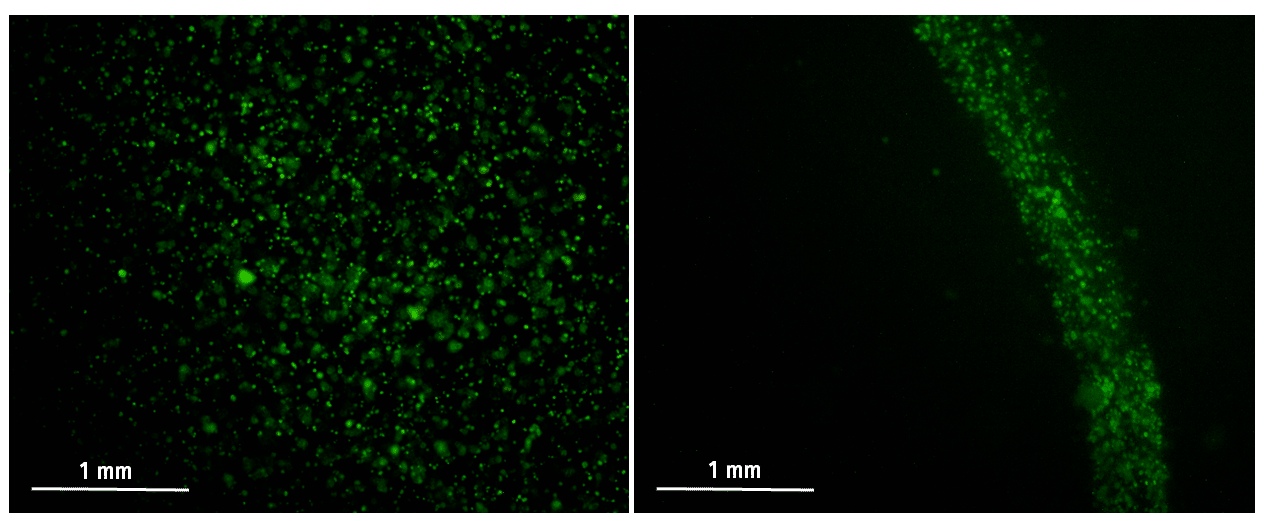
Sodium alginate is a naturally derived biomaterial that can be chemically crosslinked with calcium chloride to create cell-laden hydrogels. These reagents are used in a variety of applications including bioprinting. The recommended preparation provided in the user instruction below yields a streamlined matrix bioink that supports 3D printed cell-laden constructs. As sodium alginate cannot support itself before it is crosslinked, we recommend using Pluronic F127 or a gelatin bath as a sacrificial support. However, users can modify the preparation to suit their needs. Read on to learn the methods of sodium alginate bioprinting.

Storage and Handling
- Dry Sodium Alginate powder should be stored at room temperature.
- Solubilized Sodium Alginate should be stored at 4ºC in an airtight container.
- Calcium Chloride should be stored at room temperature in a dry environment.
You Will Need
- Sodium alginate
- Calcium chloride
- LifeSupport for FRESH
- Needles
- We suggest these 0.25″ 30 gauge needles for 2% alginate solutions
- We suggest these tapered 25 gauge needles for 5% alginate solutions
- Petri dish or well plate for printing
- Optional: transwell plates can help avoid sample loss or damage throughout experiment. Keep in mind though that transwell membranes may inhibit imaging processes.
- Sterile filters
- Syringes
- For the Allevi 1/3/6: 5mL syringes
- For the Allevi 2: Sterile 10 mL syringes
- Media without calcium or magnesium
- Sodium alginate can be dissolved in deionized water.
- Deioinized Water
- Sterilized Phosphate Buffered Saline (PBS)
Instructions for Use
Prepare the Sodium Alginate
- Dissolve 2% or 5% (w/v) sodium alginate in media without calcium or magnesium under stirring at 60°C. Regularly check and mix with spatula to speed up process. (Sodium alginate may be dissolved up to 24-48 hours in advance of use.)
- *Sterile filter sodium alginate with a 0.45 µm filter into a sterile container.
- Allow solution to reach 37°C. Mix in desired cell type and concentration. Be sure to pipette vigorously to achieve a homogenous solution.
Prepare Calcium Chloride solution
- Dissolve 100 mM (0.011 g/ml) concentration of calcium chloride in deionized water. (Calcium chloride solution may be made 24-48 hours in advance of use.)
- You will need enough calcium chloride to be able to submerge your samples.
- *Sterile filter calcium chloride solution with a 0.22 µm filter into a sterile container.
Prepare FRESH
For use with alginate, you will suspend FRESH in 0.1 wt% CaCl₂ solution as noted in our protocol on how to prepare FRESH.
Print Settings
| Layer Height (mm) | Speed (mm/s) | Pressure (PSI) | Temperature (°C) | Needle | Crosslinking | |
|---|---|---|---|---|---|---|
| Alginate (2%) | 0.15 | 6 | 7.5 | RT | 0.25″ straight 30G | Chemical (CaCl2) |
| Alginate (5%) | 0.15 | 6 | 15 | RT | 0.25″ straight 30G | Chemical (CaCl2) |
Post-print settings

- While printing, heat the sterilized solution of CaCl2 to 40-50°C.
- After the printing has finished, crosslink the finished structures in the heated solution. Crosslink for 15 minutes at room temperature. This will melt the FRESH while chemically crosslinking the alginate.
- After crosslinking samples, wash each structure 3 times with PBS, then add media.
- Incubate as needed.
* If not using cells, sterile filtering steps may be skipped.
Notes
- Adjust gelation time and gel stiffness by varying the concentration of alginate and calcium chloride as well as the crosslinking time. For help adjusting print parameters please contact [email protected].
- A fill volume change of more than 2 mL may affect pressure settings.
Further Information
- Bioprinted alginate viability results
- Sodium Alginate SDS
- Calcium Chloride SDS
- Sodium alginate troubleshooting guide
- FRESH troubleshooting guide
For further questions about sodium alginate bioprinting or information about these products, please contact [email protected].

